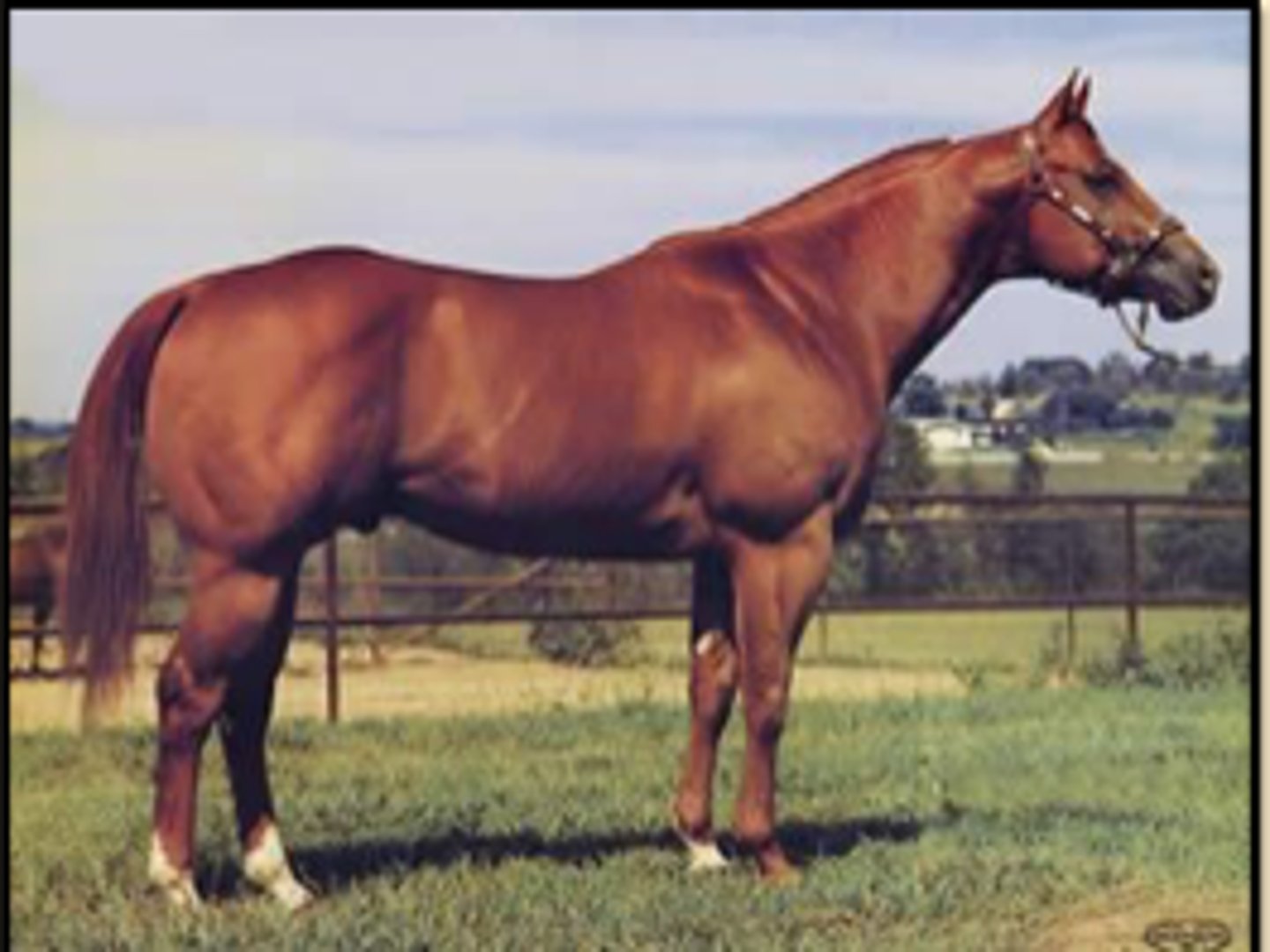Skeletal Muscle System
1/54
There's no tags or description
Looks like no tags are added yet.
Name | Mastery | Learn | Test | Matching | Spaced |
|---|
No study sessions yet.
55 Terms
Clostridium septicum, C. chauvoei, and Corynebacterium pseudotuberculosis
What are the 3 examples of things that cause bacterial myositis?
Malignant edema
What is the common name for Clostridium septicum?
Blackleg
What is the common name for Clostridium chauvoei?
Pigeon fever
What is the common name for Corynebacterium pseudotuberculosis?
Rancid butter smell
What type of smell does Clostridium chauvoei have?
Ingestion of spores or traumatic muscle injury --> Muscle, CT, and nervous tissue gangrenous (tissue death due to lack of blood supply to an area) emphysematous myositis (necrosis) caused by alpha and beta toxins released from C. chauvoei vegetative forms in SI (when ingested)
What is the pathogenesis of Clostridium chauvoei?
Cattle, goats, sheep
What animals does Clostridium chauvoei affect?
Horses, pigs, cattle, sheep, goats
What animals does Clostridium septicum affect?
Secondary to penetrating wound which carries spores into the wound: castration, injection site, tail docking, where the injury makes an anaerobic environment so the spores can be vegetative and release toxins (like Clostridium chauvoei) --> necrosis and edema
What is the pathogenesis like for Clostridium septicum?
Clostridium chauvoei (Blackleg). Dark red areas are caused by hemorrhagic necrosis of the affected muscle. (a differential could also potentially be C. septicum but there would be history of penetrating wound)
What are you looking at in this cow? Describe what you are seeing.
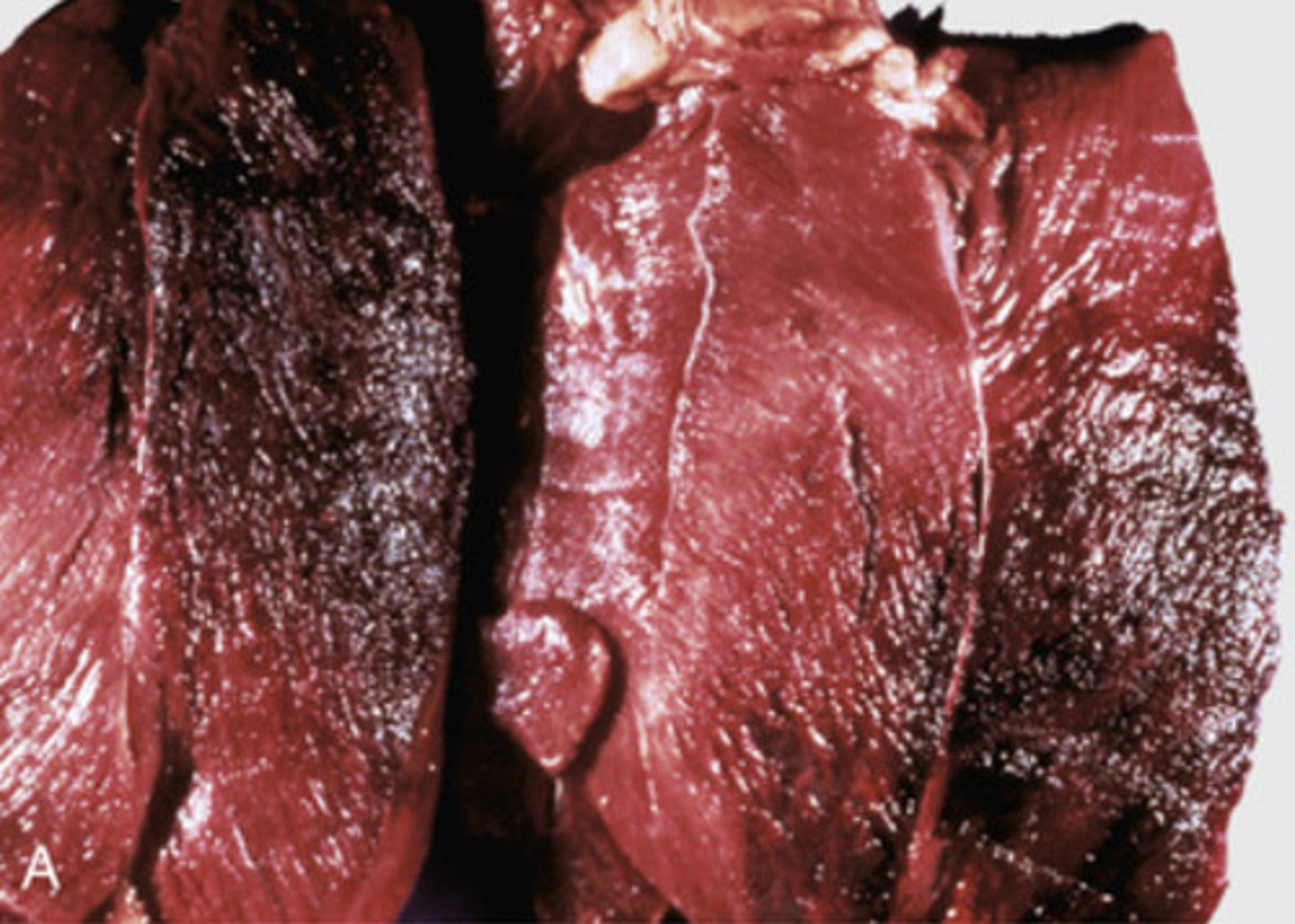
Clostridium chauvoei (Blackleg). Clostridium chauvoei produces substantial quantities of gas within infected tissues within hemorrhagic and necrotic muscle. (a differential could also potentially be C. septicum but there would be history of penetrating wound)
What are you looking at in this cow? Describe what you are seeing.
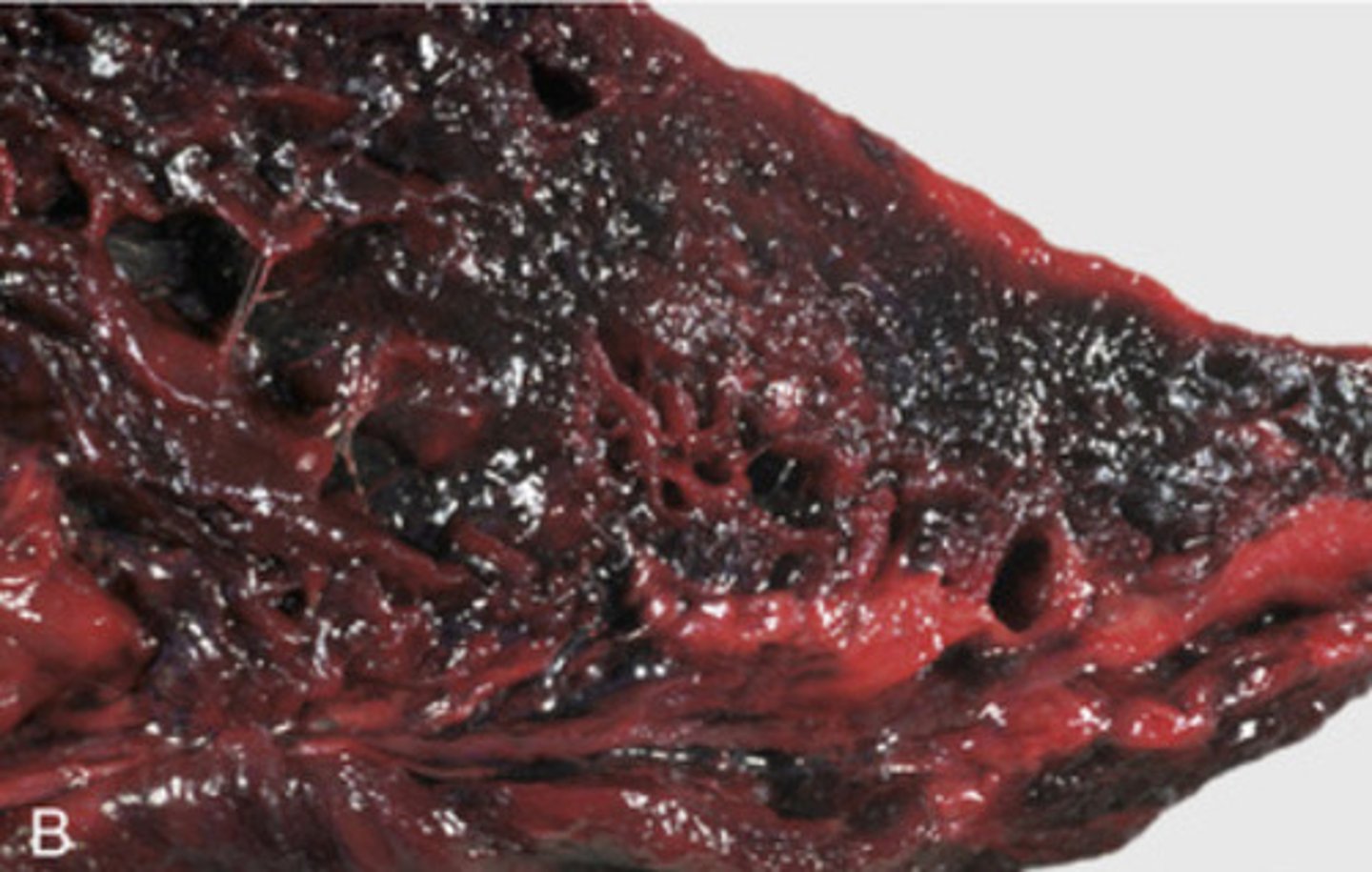
Hemorrhage and necrosis
What are some characteristic traits of "Clostridium" you should automatically think of if you see it?
YES
Is there a vaccine for Clostridium chauvoei?
Clostridium septicum
What is the most common cause of clostridial myositis in horses?
Clostridium septicum (malignant edema). The affected muscle is swollen and hemorrhagic. (this is NOT C. chauvoei because that doesn't happen in horses)
What is happening in this horse?
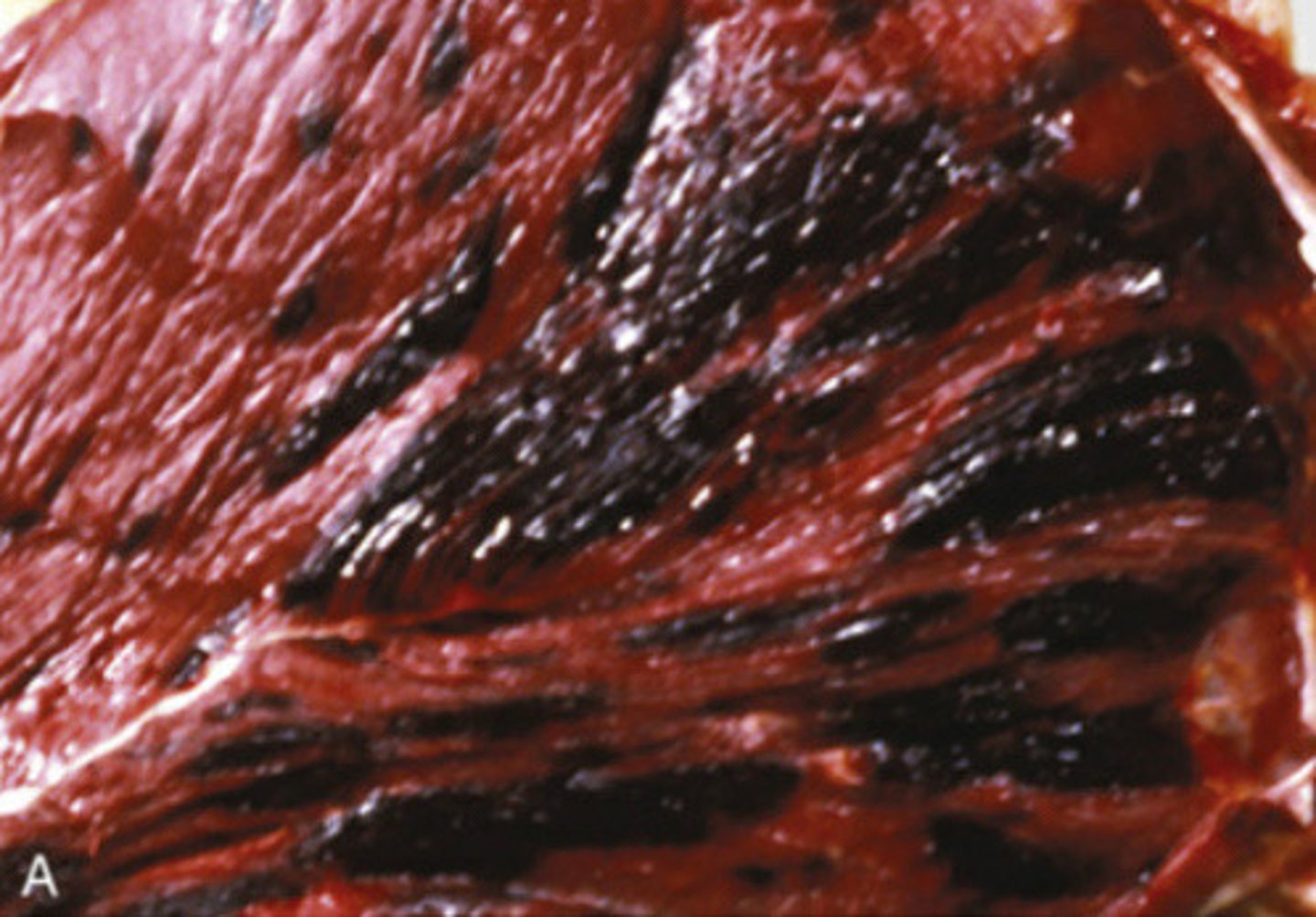
True
TRUE OR FALSE: Death from Clostridium septicum will occur within 48 hours via septicemia or toxemia.
Clostridium septicum (malignant edema)
In horses, this bacteria causes affected muscle and fascia to become swollen, hemorrhagic, edematous, and suppurative with the presence of gas
Treat RAPIDLY: surgical incision into affected muscle - drain and oxygenate, antibiotics, supportive
What is treatment like for Clostridium septicum?
Enters muscle via penetrating wounds, including injection sites
How do horses get infected with Corynebacterium pseudotuberculosis?
FALSE: The biotype most common in horses is DIFFERENT from the one that affects sheep and goats.
TRUE OR FALSE: The biotype of Corynebacterium pseudotuberculosis that affects horses is the same one that affects sheep and goats.
Purpura hemorrhagica
Corynebacterium pseudotuberuclosis can lead to what other infection in horses?
Pectorals
Infection of horses with Corynebacterium pseudotuberculosis are commonly in what muscle, causing abscesses?
Interstitial and perivascular lymphocytic infiltration
What is the characteristic histological pattern of immune mediated myositis?
Polymyositis
In dogs, this is the result of immune mediated inflammation that attacks components of the skeletal myofibers and causes necrosis, typically occurring in dogs with thymoma
Polymyositis
In dogs, this condition affects muscles throughout the body, but atrophy of the temporal and masseter muscles are most obvious in addition megaesophagus
Temporal and masseter
In dogs affected with polymyositis, all muscles are affected. Which muscles have the MOST OBVIOUS atrophy?
Polymyositis, Masticatory myositis (also myasthenia gravis)
Name a few immune mediated muscle disorders related to dogs:
Purpura hemorrhagica (after exposure to Strep equi ssp equi), post exposure to equine influenza
Name a few immune mediated muscle disorders related to horses:
Polymyositis affects ALL muscles, though atrophy is most obvious in temporal and masseter.
Masticatory myositis is specifically localized to facial atrophy.
What is the difference between dogs affected with polymyositis and masticatory myositis?
Masticatory myositis
Dogs are affected with this condition when antibodies form to type 2M myosin fibers which are only found in masticatory muscles
Masticatory muscles
Where is the only place where type 2M myosin is found?
Masticatory muscles: temporalis and masseter muscles
What muscles are affected when dogs have masticatory myositis?
Masticatory myositiss
Dogs with this condition present with bilateral symmetric swelling and pain of the jaw muscle, making the unable to fully open their jaws. Appetite is retained
Chronic masticatory myositis, severe atrophy of the temporalis and masseter muscles
What is happening in this dog? Note there is a retained appetite.
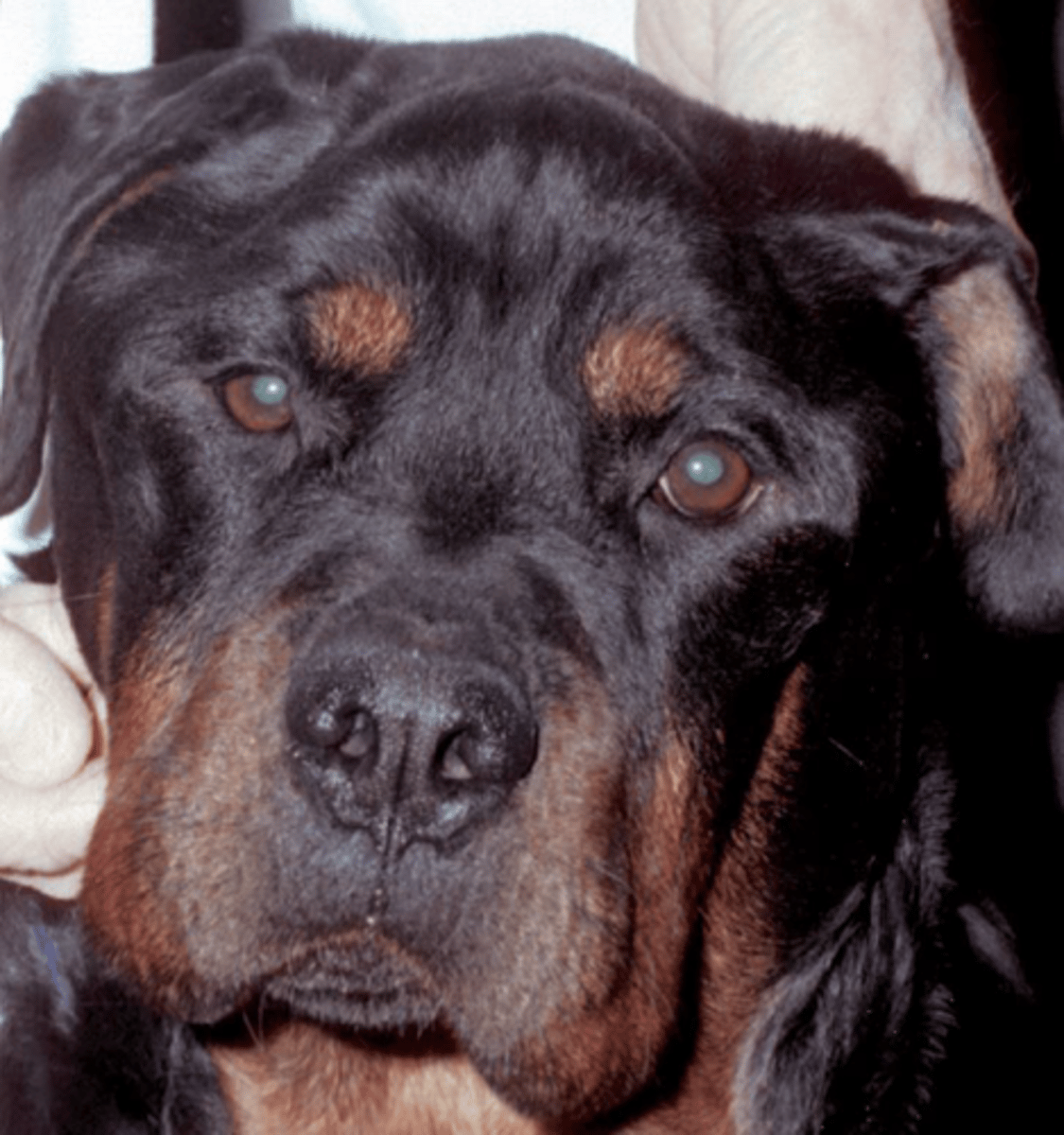
Serologic testing to detect anti-type 2M myosin antibodies
How can you diagnose masticatory myositis in dogs to differentiate it from polymyositis?
Strep equi ssp equi
What bacteria can lead to purpura hemorrhagica (immune mediated muscle disorder)?
FIV
What is an immune mediated myositis that has been described in cats?
Hyperkalemia Periodic Paralysis
What HYPP stand for?
Horses (quarters)
What animal does HYPP affect?
Impressive
Horses affected with HYPP are descendants of which stallion's bloodline?
Dominant
HYPP is autosomal dominant or recessive.
Laryngeal muscle dysfunction (laryngospasm and labored breathing) = typically don't survive
How will HYPP present in foals affected homozygously?
point mutation in alpha subunit of skeletal muscle sodium channel
What is the specific mutation resulting in HYPP?
Prominent muscling (look like they're on steroids)
What gross finding will be present in horses with HYPP?
1. Hyperkalemia (not always present)
2. transient myotonia (causes muscles to have delayed relaxation after a voluntary contraction)
For horses affected with HYPP:
1. what will potassium look like?
2. what happens to their muscles after contraction and relaxation?
HYPP (hyperkalemic periodic paralysis)
You see a horse with muscle spasms and flaccid paralysis, hyperkalemia and a known Impressive bloodline. What is it affected by?
TRUE
TRUE OR FALSE: Horses with HYPP with have normal CK, AST, and histologically normal skeletal muscle, where the only reliable test is DNA based to find the Impressive bloodline because they are not always hyperkalemic.
Malignant hyperthermia
What disorder is characterized by unregulated release of calcium from the cytoplasmic reticulum, leading to excessive myofiber contraction that generates heat leading to increased body temp and death
True
TRUE OR FALSE: Malignant hyperthermia is typically fatal.
Malignant hyperthermia/Porcine stress syndrome/Pale soft exudative pork. The affected muscles are pale pink, moist, and swollen and have a "cooked pork appearance". Unregulated Ca release leads to dystrophic mineralization
What is happening in this pig specimen?
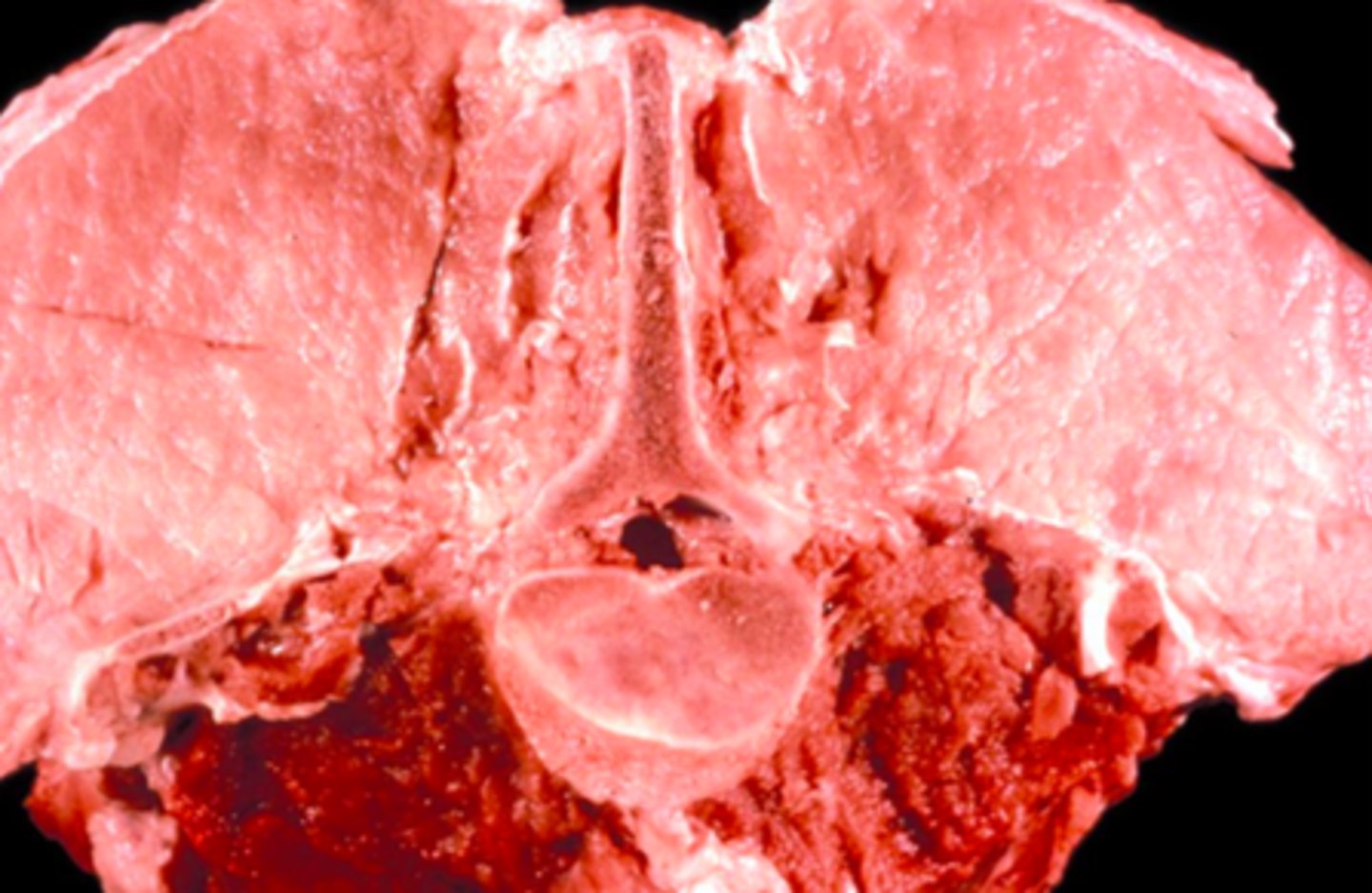
Horses, dogs, and pigs
What animals can Malignant hyperthermia affect?
Congenital defect in ryanodine receptor (SR Ca+ release channel)
A congenital defect where causes malignant hyperthermia?
Porcine Stress Sydrome: triggered by anesthetic agents like halothane (develop malignant hyperthermia under inhaled anesthesia)
What agents have the ability to trigger Malignant Hyperthermia in pigs? What is this called?
Hypermetabolism (distinguishes it from "true" malignant hyperthermia)
When horses are affected by Malignant Hyperthermia while under general anesthesia, what is this condition called?
HYPP
You see a horse muscled like this. What is your first thought?
